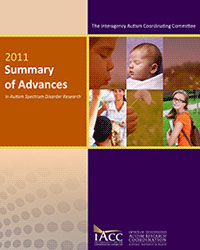Summary of Advances
In Autism Spectrum Disorder Research
2011
Post-high school service use among young adults with an autism spectrum disorder – Shattuck PT, Wagner M, Narendorf S, Sterzing P, Hensley M. Arch Pediatr Adolesc Med. 2011 Feb;165(2):141-6. [PMID: 21300654]
A study of service use among young adults with autism showed a dramatic decline in the use of services after leaving high school. Use of medical, mental health, and case management services decreased, with nearly two-fifths (39%) of young adults reportedly receiving no services at all. The loss of school-based services comes at a critical juncture when young adults with autism may be transitioning into a new living situation, forming new types of relationships, or adjusting to the demands of work or vocational training. Researchers analyzed data about service use provided by 410 families of young adults with ASD, 19 to 23 years of age, who had recently left high school. This information was compared to data collected from most of the families six years earlier. While in school, 46 percent of the adolescents received mental health services, 47 percent received medical services, and 64 percent had a case manager. Six years later, these figures fell to 35 percent receiving mental health services, 24 percent receiving medical services, and 42 percent with a case manager. The greatest decline was seen in speech therapy, with a drop from 75 percent to 9 percent in the years following high school. Race and socioeconomic status played a strong role in predicting levels of service engagement, with African-American youths more than three times as likely to become completely disengaged after leaving school compared to white youths. Young adults from families making less than $25,000 annually were almost six times more likely to be disengaged than those from more affluent families making $75,000 a year or more. The authors note that these disparities indicate a need for targeted outreach and services.




